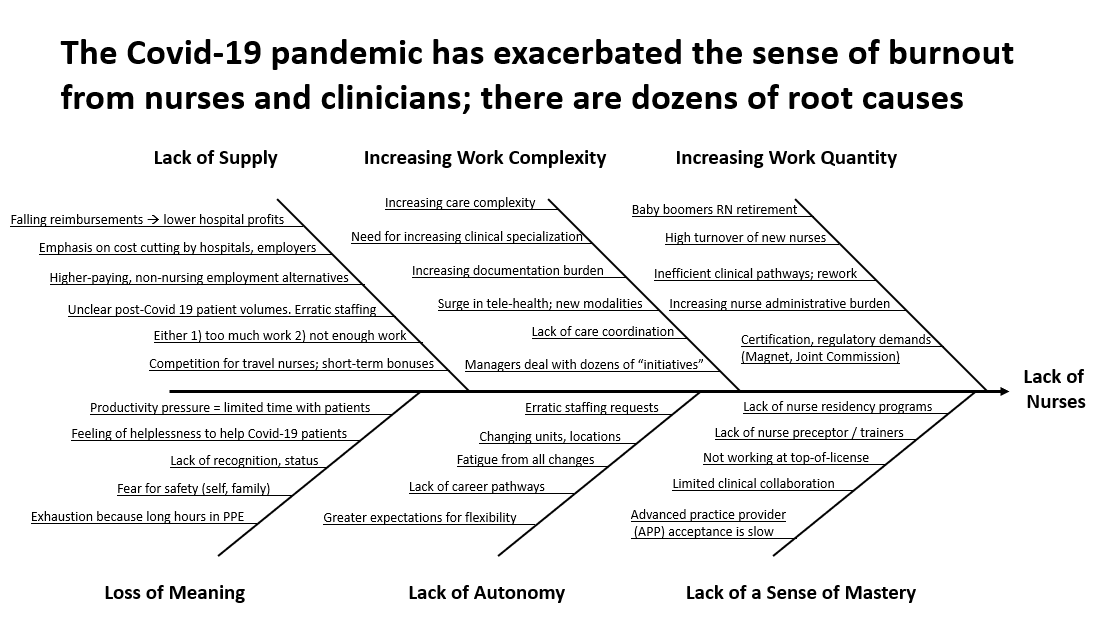30%+ of Nurses are Thinking about resigning
Let’s agree that 30% is a big number. You don’t have to be an expert in organization design and change management to see that if 1/3 of your workforce is unhappy or disengaged, that’s a problem.
In contrast, if you are a nurse or have family/friends in nursing, this estimate probably doesn’t surprise you. Nurses do a LOT of work. Diverse and challenging work – everything from charting vitals to comforting patients. This can be tiring work, and THEN, add in the extra burden that Covid-19 has given us: uncertainty and fear of an unknown virus, haphazard US response in 2019, and working under a suit of protective equipment.
McKinsey discovered that “more than 30 percent of nurses are thinking of leaving direct patient care” See the study here. Too much work, not enough pay, not enough respect, too much paperwork. The list goes on, and on.
So I started “getting smart on the topic”
The McKinsey article was 9 pages, but I wanted to dig some more. As I did some light research on the topic, I discovered that this problem has been around for 20+ years (if you type in “nurse attrition” one of the first Google search results is a article from 2002). So clearly, this is not a simple problem. Simple problems have been solved already, only the messy, cross-functional, misaligned, miscommunicated, poorly governed problems remain. Yes, nursing attrition is one of those problems.
My favorite healthcare resource: www.Advisory.com
This is a consultancy / research group that was purchased by United Health’s Optum group. I am a huge fan of the work they do because it’s simple, data-driven, and focused on practical application. Basically, US healthcare has massive problems, and we need to start fixing them immediately. I read through a dozen articles with titles like:
- 5 Ways to Invest in Your Nursing Leaders
- First-year Nurse Retention
- Addressing Physician (and Nurse) Burnout
- Leading through Crisis
- 6 Strategies to Build Your Future Workforce
Small kvetch. They used to offer hundreds of free (and informative) videos about healthcare. Great public service, but now those same videos are behind a paywall. Of course I want them to be profitable and protect their IP, but let’s also agree there is a lot of public health-related content that would be a public service. I emailed them.
Lots of details, how to organize this?
As with any research effort, I started by reading and skimming lots of articles. We all know that it’s important to go broad first. Open the problem up slowly, give yourself some time to identify the potential boundaries of the problem. As you will see, the root causes of the nursing crisis are diverse.
So, yes, this go-slow-at-first process is informative, but it’s also disorienting. My metaphorical legal pad got full very quickly with facts, anecdotes, thoughts. How to catalog all this stuff so it makes sense?
Put things in buckets
If you know me, or have been reading this blog for a few years, you know that I love buckets. One consulting tool to group details into root cause drivers is a “fishbone” diagram. Also, called a Ishikawa diagram.
Wait, what’s a fishbone diagram (Ishikawa diagram)?
Take a look below.
1) You will see the main problem show on the right. “Lack of nurses”
2) Then you start the somewhat messy process of grouping the details, facts, and tidbits
3) You keep grouping, regrouping them. Of course, if these buckets can be MECE (mutually exclusive, collectively exhaustive) that’s ideal, but it also needs to make common sense to you and the client.
4) Visually, the skeleton of the fish (or the branches of the tree) has the different groupings.
5) After some back/forth and synthesis of a bunch of articles, I landed on these drivers:
- Supply / demand – not enough nurses, erratic work schedules
- Work complexity – more complexity, administration, and largely the same pay
- Work quantity – more work, fewer people (lots of baby boomers will be retiring)
- Loss of meaning – too much administration, not enough patient care
- Lack of autonomy – enhanced expectations for flexibility
- Lack of sense of mastery – not empowered to “work at the top of their license”

Useful tool
I know it’s an eye-full, but that’s kind of the point. You take all your data (points, especially when there are too many), and you aggressively group them. Putting things into buckets. Organizing your thinking. Telling a story. PRO: You can show a lot of data in a small space. PRO: It forces you to do the thinking. CON: There are inevitably some “judgement calls” you need to make (which bucket does the observation belong to)?
Nursing shortage
Building off the siren call from the 2002 article, we are 20+ years later and the same challenges remain. If you go to the nurses industry group, American Nurses Association, they point many of these elements which need to change by regulation. However, if you look closely at the drivers, it’s more than what CMS can do. A lot of these changes are economic, industry-driven, practical, educational, and even cultural.
Example #1: Why aren’t there more male nurses?
So, here’s a fascinating thought-experiment for you. Why are 88%+ of nurses female? Great NPR podcast here.
Thank a clinician
You know, the list of challenges I put on the fishbone diagram? They apply to most clinicians. The US healthcare systems is fragmented, rife with paperwork, principal/agent problems, and gamesmanship. There are dozens of structural problems that need to be fixed, and it will take leadership and career risk.
Take a bit of time today and thank someone who is in healthcare AND making a difference. I have family members who are clinicians. I plan to thank them today.
